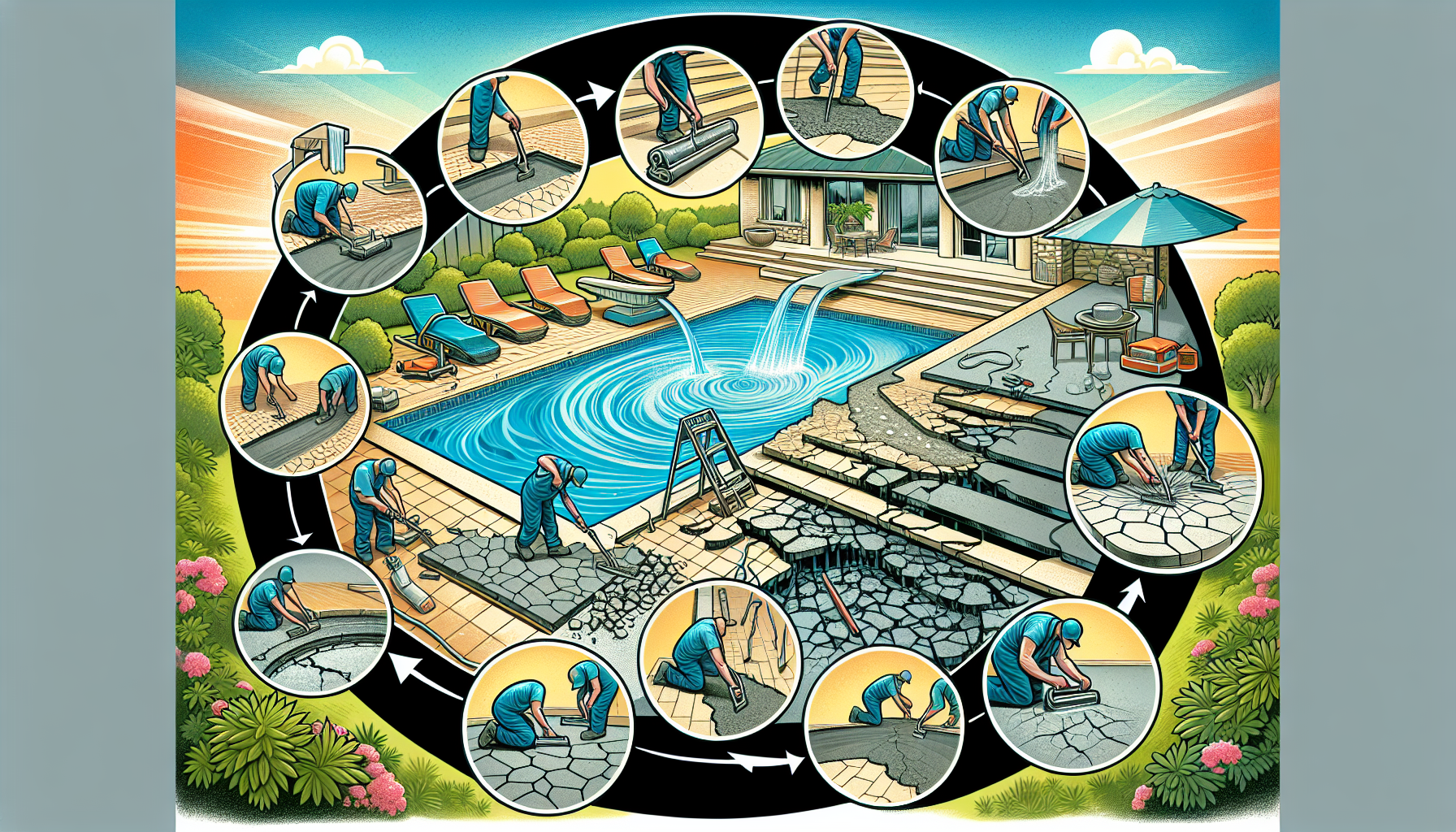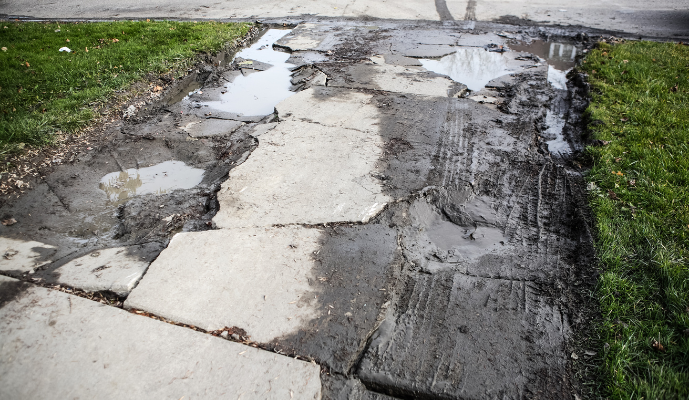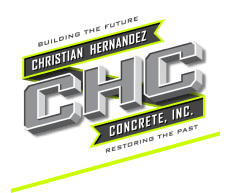If you’re encountering problems with your pool deck or driveway, this guide offers professional insights into the repair and maintenance of these surfaces. Discover methods for detecting cracks in your pool or deck, effective maintenance strategies to prolong their lifespan, and advice on selecting durable materials to ensure enduring repairs.
Key Takeaway
- Understanding the causes of driveway and pool deck cracks is essential to effectively addressing them, ranging from substandard materials and poor installation to weather-related factors and ground movement.
- Surface cracks can often be repaired promptly with preparation, cleaning, and the application of epoxy sealers, while structural cracks may require more robust techniques like the stitching method or the use of specialized repair mortars.
- Regular maintenance, including cleaning, sealing, and inspections, is crucial for preventing damage and extending the lifespan of driveways and pool decks, offering both aesthetic and practical benefits.
Understanding Driveway and Pool Deck Cracks

Comprehending the underlying causes of cracking in both driveways and pool decks is essential for effective intervention. Cracks underlying concrete can often originate from inferior materials or flawed installation practices. Utilization of subpar construction substances coupled with insufficiently thin surface treatments can result in structures that are more susceptible to developing cracks, whereas incorrect placement by uncertified contractors may lead to inadequate reinforcement and support. Shifts in the ground stemming from a poorly constructed foundation or base can impart undue stress on concrete surfaces, precipitating crack formation as time progresses.
Climatic elements also significantly influence crack development. In regions where temperatures plummet below freezing, concrete and asphalt surfaces suffer greatly due to freeze-thaw cycles. Water penetrating minuscule fissures on existing concrete surfaces and then freezing leads to its expansion, which exacerbates existing cracks and potentially inflicts greater damage to the structure’s integrity. Conversely, high-temperature environments cause concrete to expand upon heating up, which results in fracture when it encounters rigid boundaries around it like adjacent walls or fixtures, making them unable to withstand heat-induced growth without breaking apart. Natural terrestrial dynamics including seismic activity and thermal fluctuations cause these structural disruptions within driveway & deck paving alike.
It is crucial during an evaluation phase to make a distinction between merely superficial versus structurally compromising breaks present inside any given area, including pools. Or pathways. Superficial varieties Manifest shallow depth while not necessarily threatening overall stability. Such instances commonly follow excessive loss of moisture especially in affected areas when the original composition was overly saturated initiating period drying after pour For situations involving deep-rooted splits this suggests far-reaching concerns underpinning material itself possibly linked to setting process left voids underneath the area subjected forces expansive flora nearby piecing together nature genesis concerned segmentation aids coming proper mode rectification avoiding reoccurrence moving forward.
How to Fix Surface Cracks
It is crucial to address cracks in surfaces like pool decks and driveways early on to avert more severe structural problems. The initial step for fixing such surface imperfections involves thorough preparation. Make sure that the crack is bone-dry before commencing repairs. If it’s damp, you might need to use something like a hairdryer to evaporate any residual moisture. Then clear out the crevice using a wire brush, excising all loose concrete fragments, peeling paint or preexisting fillers, this ensures the new repair material will properly bond with the current concrete base.
Once you’ve confirmed that both cleanliness and dryness criteria are met for your crack, proceed with applying an epoxy sealer through these steps:
1. Blend equal proportions of Part A and Part B until they form a consistent gray shade.
2. Apply copious amounts of this mixture over and along each side of the fissure—ensuring about one inch margin on either flank.
3. In instances involving wider gaps, consider installing injection ports by sinking finishing nails at intervals along them (roughly every 12 inches) then anchoring plastic injection tubes onto those nails using some of your mixed epoxy.
For cementing up your deck or driveway thoroughly after laying down an adhesive foundation with sealer—which requires between six and ten hours for hardening—you can commence injecting from below upwards port by port while sealing off each once filled before proceeding onwards as necessary so as not leave anything untreated beneath surface level resulting in much stronger sustained fixes overall post application process which should be finalized within five days upon which point trimming away protruding injector tube remnants caps things perfectly: leaving formerly cracked space sealed tight against future incursions when done correctly making them good-as-new again!
Repairing Structural Cracks
Structural integrity and safety over the long term necessitate more advanced solutions for repairing structural cracks in driveways and pool decks. Stitching is a robust method that effectively handles substantial cracks, which include:
1. Creating holes adjacent to each side of the crack
2. Securing metal staples or stitches into these holes to arrest Opening
3. Filling the fissure with a specialized mortar blend to solidify the repair
This technique provides much-needed reinforcement for sizeable, problematic cracks.
Repair mortars stand out as an ideal choice when it’s necessary to fill significant voids or mend overhead, horizontal, or vertical fractures due to their excellent adhesion properties with existing concrete surfaces and ability to restore stability. In scenarios where moisture penetration poses problems like in foundations or below-ground levels, hydraulic cement offers an optimal fix because it expands upon setting—this quality ensures a watertight barrier against future water ingress. Choosing suitable materials for concrete repairs requires attention to compatibility with the initial concrete mix used during construction—particularly if there was pre-existing weak concrete involved.
Dry packing presents yet another solution for mending structural breaches by using a dense mortar mixture made from one part cement mixed with two-and-a-half parts sand combined minimally moistened—to produce pliable but solid matter recommended especially for filling gaps left after removing bolts or ties along with patching slender deep crevices.
No matter what repair process is applied, confronting the causes behind cracking remains critical in guaranteeing durable maintenance outcomes. Such actions might include enhancing drainage systems, tackling soil disturbances underneath structures and strengthening foundational supports—all aimed at mitigating recurrences of any splits on those repaired sites.
Resurfacing Driveways and Pool Decks

When the extent of cracks and damage grows from too much water at large, an effective method to revitalize both appearance and function of a pool deck or driveway is through resurfacing. This process commences by stripping off the old coating to expose the concrete underneath, which guarantees strong adhesion for a lasting finish. Repairing any existing imperfections in the concrete is crucial before moving on with resurfacing.
Following necessary repairs to the current concrete deck, preparation of the surface for overlay application includes deep cleaning and applying an adhesive promoter to secure proper bonding. With a prepared base, installation of a new layer stamped concrete ensues as groundwork for additional coatings. The new overlay offers flexibility in customization for enhanced textural options and patterns that significantly alter your space’s aesthetic appeal.
Resurfacing opens up opportunities for total transformation of concrete slab surfaces with various choices offered by companies like SUNDEK such as:
- An array of colors
- Texture varieties
- Unique effects
- Saw cut designs
- Mixed aggregates
- Stamped overlays
Incorporating these features allows creation tailored design solutions rich in uniqueness while allowing homeowners precise control over their desired look—be it replicating natural stone patterns, fashioning contemporary designs or injecting color new life into areas surrounding swimming pools.
Practically speaking, enhancing your swimming pool deck through resurfacing has its advantages.
It heightens slip resistance, promoting user safety around wet areas.
Surfaces become cooler underfoot due to improved heat reflection.
- Conceals pre-existing blemishes renewing aesthetics near swim zones.
Potentially increases property value from updated appearances.
To cap off resurfacing operations successfully—a sealant equipped with anti-slip properties may be applied not just securing durability but also advancing safety aspects associated with newly treated surfaces.
Choosing the Right Materials for Repairs
Securing the appropriate materials for your driveway and pool deck repairs is crucial to ensure both efficiency and longevity. The right material selection can lead to years of durable repairs, while a poor choice may result in quick deterioration. When determining which pool deck repair top options are optimal, consider factors such as type of damage present, placement of the needed repair on the surface, and environmental challenges that may impact durability.
Homeowners who opt to perform concrete repair tasks should seek advice from coating manufacturers who provide guidance tailored to do-it-yourself projects. Manufacturers typically have an array of products specifically crafted for concrete patching needs and offer recommendations regarding:
- Ideal patch kits
- Color matching techniques for uniformity with current surfaces
- Top-rated solutions adapted to individual conditions including local weather patterns, regular wear-and-tear levels experienced by the surface area being repaired
Using high-grade materials designed explicitly for their intended use along with heeding manufacturer’s directions increases substantially the probability that your deck or driveway will be restored effectively with results that endure over time.
Preventative Measures to Avoid Future Damage
Preventing damage to your pool deck and driveway is more economical than fixing it afterward. Regular inspections are vital for early detection of potential problems such as signs of wear, including loose railings or beginning stages of decay. Addressing these issues promptly can help avoid larger, costlier repairs later on. Ensure that the entire area is checked thoroughly during these evaluations – don’t skip any sections, even those not typically seen during a standard clean-up.
Maintaining your surfaces appropriately plays an essential role in preventing damage. It’s recommended to clean pool decks every two to three years to eliminate accumulated grime, soil, mildew, and residual chemicals from pools which could result in stains or cracks and deterioration due to chlorine exposure. Routine cleaning maintains the aesthetic appeal while safeguarding structural integrity. Be mindful when choosing methods and products so as not to destroy the surface material—especially with composite decks where high-pressure washing may cause harm.
Ensuring efficient drainage is crucial for maintaining your pool deck’s and driveway’s structural health because insufficient drainage can prompt water pooling that exacerbates crack formation—a particular concern in regions experiencing freeze-thaw cycles commonly associated with colder climates. Periodic sealant application offers protection against environmental factors thereby prolonging their durability. Should you notice minor cracking develop it’s imperative to conduct immediate repairs thus preventing water infiltration leading potentially serious complications. By adhering strictly preventive measures like these will dramatically decrease necessity major fixes extend overall lifespan both structures.
DIY vs. Professional Repairs
Many homeowners are faced with the decision whether to undertake repairs on their driveway or pool deck themselves or enlist the services of a professional. Self-repair projects have certain appealing factors, including:
- The potential for savings on labor costs.
- Greater control over the design and aesthetic outcome that aligns with personal preferences.
- The appeal is heightened for those who relish direct involvement in crafting their external living spaces.
It’s crucial to weigh these benefits against possible drawbacks associated with DIY endeavors. Inexperienced repair work may lead to:
- Subpar finish quality,
- Unintended safety issues,
- Mistakes requiring subsequent fixes which could offset any initial financial advantages.
This holds even more true when complex tasks are at hand or specialized materials necessitate exact application methods.
On the other hand, opting for professionals can incur higher immediate costs but comes with considerable merits. Contractors possess distinct expertise and use premium materials not typically within reach for average individuals. Their services prove particularly advantageous for extensive undertakings, challenging configurations like steeply inclined decks, or scenarios where precision leveling of unique materials is paramount. Professional jobs frequently include warranties ensuring confidence and protection from future complications. For operations such as pressure washing surfaces near pools and decks, there is a diminished likelihood of surface damage due to inaccurate handling techniques by skilled experts.
Choosing between going solo versus hiring a contractor hinges upon several variables: project complexity level. One’s competencies in maintenance works. Readiness to dedicate time to effectuating deck repairs surrounding your home’s pool area or its adjacent driveways.

Maintenance Tips for Longevity
Consistent maintenance is key to extending the life of your pool deck and driveway. Engaging in regular cleaning helps prevent damage over time and retains the appearance of these areas. Removing debris, soil, and substances that could cause stains will safeguard against deterioration. For effective cleansing, a pressure washer can be employed. Caution should be taken to adjust it properly for various materials such as composite decks which may sustain damage from high pressures. After washing, let the surface dry thoroughly—this might take up to three days.
For persistent marks or algae accumulation on surfaces, choosing suitable cleaners that don’t emit alkaline chemicals is essential.
- Employing muriatic acid mixed with vigorous scrubbing may eradicate algae on deck pavers.
- Match cleaning agents specifically to your decking material when tackling different kinds of blemishes.
- Refrain from using strong chemicals that may mar the finish of your deck.
If common household products fail to effectively remove tough dirt or discolorations, consider enlisting professional services designed for this purpose.
To ensure additional protection for both driveway and pool of existing concrete deck is:
- Apply a waterproof sealant which provides defense against moisture infiltration as well as sun-induced wear-and-tear – promoting longevity.
- Place protective padding beneath furniture legs so they do not scratch or impair your decking area.
Make sure all objects are routinely removed from the area surrounding pools in order to diminish grime build-up along with mold formation.
Adopting these preventative steps guarantees prolonged durability plus pristine condition across driveways and decks for many future years—keeping them invitingly presentable throughout their use-span.

Benefits of Regular Maintenance
Maintaining your concrete pool deck and driveway regularly offers more than just visual enhancement. By swiftly tackling any emerging issues, you can stop a cracked or settling concrete surface from evolving into an unsightly and hazardous situation. Taking this preventative stance towards upkeep is economical over time, as it circumvents the need for complex, costly repairs later on. Consistent care ensures that your property retains its value by keeping outdoor areas secure and attractive.
The perks of routine maintenance are twofold: they safeguard the structural soundness while also elevating the aesthetic charm of your exterior spaces. Preserving both your driveway’s condition and pool deck not only augments the beauty of your residence, but also fosters a welcoming atmosphere for occupants and visitors alike. Such meticulous attention could greatly influence prospective buyers’ perceptions, potentially boosting home resale values.
Regular inspections enable early detection of possible hazards in these surfaces before they intensify into larger problems, ensuring year-round security in these recreational zones. In devoting regular efforts to maintain these areas, you do more than simply care for concrete patio structures. You’re securing both financial investment and enhancing everyday living quality.
Summary
To sum up, the upkeep and restoration of pool decks and driveways are critical components of home care that must not be ignored. We have delved into everything from discerning the origins of cracks to deciding whether to undertake repairs yourself or seek professional assistance, providing a thorough guide for maintaining these essential elements of your property in prime condition. Routine checks, swift repair work, and regular maintenance are fundamental in averting serious damage and promoting the endurance of your exterior surfaces. By applying the sophisticated tips and tactics delineated in this manual you can safeguard your investment – augmenting both value to your abode as well as crafting resilient outdoor environments teeming with beauty for family enjoyment over time. Do not delay until minor troubles escalate. Get in touch with CHC Concrete and Act now to maintain and improve both driveway’s integrity along with that pool deck’s allure.

